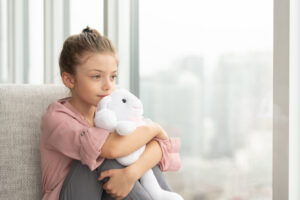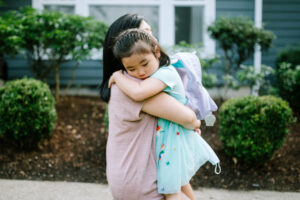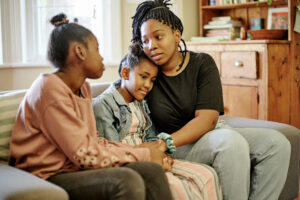From Worries to Wellness: A Parent’s Guide to Childhood and Adolescent Anxiety

Some levels of stress and anxiety can be a normal part of childhood, from monsters under the bed to stage fright before the school play. But diagnosed anxiety conditions are much more serious and require proper support and care. Children and teens can experience temporary seasons of anxiety as a result of major changes, such as a move or the death of a loved one. Or they can experience anxiety as an ongoing mental health condition.
When feelings of butterflies in the stomach or occasional nerves become unmanageable, adolescents and youth need to know they have resources and support to handle what they’re going through. Let’s explore how anxiety is impacting children today, the common types of anxiety and how parents can support a child facing anxiety.
How Anxiety Affects Youth Today
If it seems more children are anxious today than ever, you’re right. Anxiety has become an increasingly prevalent mental health problem among youth in America today, especially following the stress and isolation of a global pandemic.
In 2021, the American Academy of Pediatrics declared a national emergency in child and adolescent mental health. As of this year, approximately 1 in 5 adolescents between the ages of 12 and 17 report symptoms of anxiety or depression.
What’s driving this increase in anxiety? There are many theories as to the causes behind this heightened anxiety among youth today. The U.S. Surgeon General issued an advisory in 2023 linking the youth mental health crisis to social media. The advisory stated that “up to 95% of youth ages 13–17 report using a social media platform, with more than a third saying they use social media “almost constantly.” Anxiety is also common among teens because of the intense amount of changes their bodies and lives go through. Other factors may include personal or familial difficulties, environmental stressors or genetic disposition.
Recognizing Anxiety: Signs and Symptoms of Anxiety in Youth
Adolescents and youth, especially younger children, may not be able to identify how they are feeling and independently determine if it’s anxiety. Parents and caregivers can help children get the help they need by being in tune with their child’s health and wellbeing.
It’s important to remember that anxiety, like most mental health challenges, looks different for everyone and symptoms will vary. But you can watch for the following warning signs that may point to a greater issue:
- Changes in eating habits (overeating or not eating as much as usual)
- Changes in sleeping habits (insomnia, frequent nightmares or oversleeping)
- Difficulty concentrating
- Complaints of stomach pain, chest pain or other body aches that cannot be linked to a physical problem
- Becoming angry or irritated more easily than usual
- Acting out more than usual, including having tantrums or outbursts
- Frequently feeling restless or fidgety
- Constantly worrying or having negative thoughts
- Crying a lot more than usual
- Clingy behavior or constantly wanting to be held
- Avoidance of activities or places that were previously part of everyday routines
- Struggling with suicidal thoughts and hopelessness
 Types of Anxiety
Types of Anxiety
Children and teens can experience a wide range of anxiety disorders, and each has a different impact on what everyday life looks like. Here are several anxiety disorders we commonly treat with mental and behavioral health services at KVC:
Generalized Anxiety Disorder (GAD)
GAD generally manifests in children and adolescents as a lot of worry or fear. The youth may overly worry about things like physical appearance, upcoming events, past behaviors and failures or their personal abilities. It can be hard for a child or teen with GAD to put these worries aside, no matter how hard they try.
Panic Disorder
Panic disorders are most commonly characterized by panic attacks. These are episodes of intense fear or anxiety manifested as both physical symptoms and overwhelmed thoughts. Symptoms that may occur during a panic attack include:
- Racing heart or heart palpitations
- Choking sensations
- Difficulty breathing
- Sweating or hot/cold flashes
- Trembling or shaking
- Numbness or tingling in limbs
- Dizziness
- Uncontrollable crying
- Sudden withdrawal or dissociation
- Fear of dying, losing control or going crazy
- “Fight or flight” reactions
Phobias
Phobias can vary greatly depending on the child’s specific fears. These are often irrational fears rooted in anxiety and feelings of fear. Phobias may manifest with similar symptoms as GAD or panic disorders, but specifically concern the given phobia. Some common phobias children and teens can experience include fear of an animal or insect, blood, heights, closed spaces (claustrophobia), open spaces (agoraphobia) or flying.
Social Anxiety
Social anxiety is a form of phobia specifically relating to fears and anxiety around social situations. This is often experienced as fear and anxiety surrounding social or performative situations like school presentations, auditions or social gatherings.
 Separation Anxiety
Separation Anxiety
Separation anxiety is a widespread type of phobia common in children who have experienced a short or long-term separation from a parent or another traumatic disconnection, especially in foster care. They may struggle with severe anxiety or panic at the thought of being separated from the person they are attached to. While more frequently seen in young children adjusting to being away from home without their parents for the first time (i.e., preschoolers starting school), teens still frequently struggle with separation anxiety. Young people may struggle with separation anxiety with their foster parents or with their biological parent post-reunification.
Post-Traumatic Stress Disorder (PTSD)
PTSD occurs following a traumatic experience, which is why it is often associated with war veterans. However, PTSD can impact any person of any age. If a child or teen is experiencing fear or stress long after a traumatic event, they may need help learning to cope with what happened. Signs of PTSD include:
- Difficulty sleeping or having bad dreams
- Feeling anxious, nervous, restless or fidgety
- Becoming irritated, angry, aggressive or violent
- Returning to outgrown behaviors (such as thumb-sucking or bedwetting)
- Difficulty concentrating
- Loss of interest in things they used to enjoy
- Acting detached or unable to show affection
- Headaches or stomach aches
- Constantly worrying about dying
- Avoiding people, places or things that bring back memories
- Having flashbacks or reliving the experience over and over
How to Help a Child or Teen with Anxiety
If you believe a child or teen in your care may be experiencing a form of anxiety, you might feel helpless at first. But there is hope, and you can take some key steps to help:
Acknowledge and validate anxious feelings: Children and teens need to know they are heard and that their feelings matter. Approach the situation with kindness and understanding.
Stay calm: Your response can help the child or teen feel grounded and cared for, especially during an acute anxiety experience like a panic attack. Adolescents are especially in tune with how their caregivers handle a situation, and they need you to remain calm around them regardless of how confusing or uncertain the situation may be.
Teach self-coping techniques: You can start by sharing this playlist of exercises to help them handle situations that trigger their anxiety.
Discourage avoidance: If a situation, person, place or thing makes them anxious, it’s tempting to simply avoid it. But unfortunately, avoidance isn’t a long-term solution. For example, a student who’s feeling anxious about going to school can’t avoid class forever. Exposure, paired with professional mental health support, can be a healthy way to learn how to manage their anxiety, especially in a safe, controlled environment.
Create a mental health toolkit: This can be as simple as a mental health checklist for those anxious moments, including helpful apps like Headspace and ideas for activities that help soothe their anxiety. Learn how to make a Mental Health Toolkit here.
Seek professional support: Therapy and other professional mental health support are never a bad idea, even if the situation isn’t severe or life-threatening. If a child or youth in your care is experiencing symptoms of anxiety, seek mental health support from your nearest KVC Health Systems location or another mental health service provider.
Hope and Help for Anxiety at KVC
At KVC, our team of counselors and therapists are ready to support children and teens in navigating anxiety. Are you worried about your child’s anxiety? There is hope, and we’re here to help. Take the first step by contacting your local KVC today.








